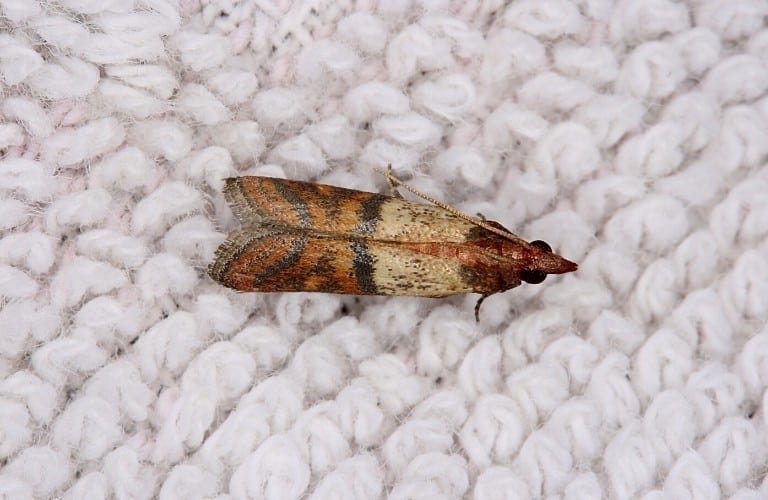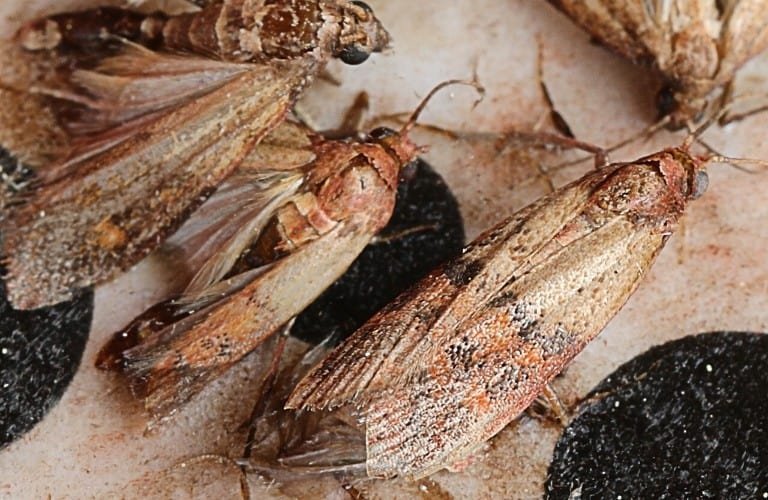If you’ve ever found moths in your house, you’ll know they can wreak havoc on your possessions, but you might not know how they got there.
Where do moths come from? Moths enter homes through contaminated food or infested clothing items brought into the house. They can also gain entrance through open doors and windows, particularly when a bright light is nearby, and damaged areas in the foundation or floors of a house.
Different types of moths can break into your house through unconventional means, and if you don’t know the signs of a moth infestation, it could cost you a lot of money.
In the following, you’ll learn how exactly to prepare for such an occurrence.
Don’t miss out key prevention tips, helpful facts about moths, and helpful elimination guides. Click here to access all of our moth articles.
How Moths Can Sneak into your House
Moths can get into a house like any other bug. They can fly in through open doors and unsealed windows. They can even hitch a ride on your shoulder!
These are not the only ways moths can get introduced to your ecosystem, however.
Certain moths can infest items from outside the house and can enter your domain undetected. The items they infest can tell you what kind of moth they are.
Species of food moths can get into your house through contaminated foods purchased from the grocery store or a farmer’s market.
Species of clothes moths can enter a house through infested items from secondhand stores or improperly stored merchandise.
Any item that has been sitting out for a while could be the target of infestation.
Because moth larvae have hearty appetites for being so small (find out what they are capable of eating here), the resulting destruction can be widespread.
So if you bring an infested item into your home, how can you tell?
Signs of a Moth Infestation
If you have suspicions that you might have a moth infestation, survey the damaged item in your home.
How does it look? Is there anything on or in the damaged item that wasn’t there before?
There is also the possibility that you haven’t found anything of yours that’s been ruined.
If this is the case, have you recently noticed any moths in your house? Even a single moth can be a sign of bigger problems.
Don’t jump to conclusions, however. Knowledge, not panic, will help you in this situation.
Just use the chart below to determine what type of moth problem you have.
| Signs of Food Moths | Signs of Clothes Moths |
| Irregular holes in pantry containers or food | Irregular holes in clothes (natural AND synthetic) |
| Eggs | Eggs |
| Larva | Larva |
| Droppings | Droppings |
| Cocoons | Cocoons |
| Webbing |
Out of all of the above, the most important thing to look out for is moth larva.
Larvae, not fully grown moths, are responsible for all the damage in a moth infestation.
In our article “How To Get Rid of Moths,” you’ll learn exactly what steps to take and discover the top-recommended products for eliminating moths from your home.
What Attracts Moths into the Home?
Though you can’t really control if you bring a contaminated item inside your home, there are things that attract these winged pests into your household.
Moths have a weakness for bright lights. Take a look at your porch lights when the sun goes down. You’ll more than likely find a few moths hanging around or bouncing into the bulbs.
It is thought moths are drawn to light due to the way they navigate using natural light, specifically the moon.
Man-made light can confuse a moth and lead them straight into your house or to their death if they get trapped in something like a wall sconce.
The following National Geographic video clip explains further.
Another thing that draws moths to people’s homes is food in the form of:
- Natural fibers.
- Hair.
- Loose grains.
- Open bags of flour.
Moths also look for places to breed in areas such as:
- Dark places.
- Locations with warm temperatures.
- Safe spaces without predators.
These factors can ultimately lead to a moth infestation!
How long do moths live once inside? Longer than you probably think. We explain here.
How Do You Moth-Proof a House?
In the end, the best way to deal with a horrible moth situation is to prevent it from happening in the first place.
The easiest thing to do to moth-proof your house is to keep doors and window screens closed tightly.
If you have screens to keep bugs out, make sure there are no rips or holes in them. Even the tiniest tear can let in a moth and cost you a lot of money.
You can further protect your possessions by being more proactive with common household issues. Issues like the following can be ideal places for moths to enter your home.
- Cracks in the foundation.
- Warped baseboards.
- Gaps in hardwood floors.
How Do You Moth-Proof a Kitchen?
Further measures you can take to moth-proof your house are specific to the parts of your household that moths will target.
For the kitchen you can keep moths from causing serious damage by keeping packaging closed tightly and cupboards neat and tidy.
Don’t leave spills on counters or in cabinets, no matter what it is. Ants aren’t the only pests drawn to food!
(Learn how to handle an ant infestation here.)
You can also purchase separate containers for things like sugar or cereal so moths can’t chew their way into your food.
A set that will hold a variety of items is ideal.
This 14-container set comes with 24 reusable labels, interchangeable lids with silicone gaskets, a chalkboard marker, one set of measuring spoons, and one set of measuring cups.
How Do You Moth-Proof a Closet?
For closets, you can make sure your clothes are clean and not packed in too tightly.
Tightly packed dirty clothes can hide moths from your sight until the damage is so great that you may need a new wardrobe.
Similar to the method for guarding against food moths, you can further protect your clothes by putting them away in airtight containers, like this 6-piece set of clear storage bins with latching lids and handles.
There are also glue traps, mothballs, and nontoxic moth repellents you can use to keep moths away from your possessions.
Glue traps use pheromones to draw in male moths, while mothballs use chemicals to ward off moths.
(Mothballs are not your safest option – see this article for alternatives.)
Another option is to use cedar rings, like this pack of 30, designed to fit directly on clothes hangers.
Additionally, you could try:
- Cedar oil.
- Cedar shavings.
- Cedar chests.
These will all keep moths away. Or you can always get a cat to be your very own moth catcher!
Lastly, if none of this helps or you enacted these measures too late, you’ll want to get professional help. Call an exterminator to rid yourself of chronic moth infestations.
The Full Moth Life Cycle
The life cycle of a moth can be important in understanding how to prevent moth infestations.
Adult moths aren’t the ones causing damage in your home. It’s their babies.
If you can catch a moth issue before they breed or before moth eggs hatch, you can save yourself a massive headache.
The life of a moth begins with a female moth laying a little minuscule egg in a safe place surrounded by food.
The larva inside the egg will eat its way out and continue to eat everything in sight.
Once the larva has hatched, it’s considered a caterpillar and will eat to grow and prepare for its next phase in life.
The caterpillar then makes a cocoon and goes through the stages of becoming a moth. The moth emerges fully grown, and it can live up to a month.
If that moth is a female, it can now use its sex pheromones to signal it wants to mate with a male moth.
A male moth will be drawn to the scent of the female, perform a mating ritual, hook onto the female moth and mate with her. Then the process starts all over again.
Watch the following video for a fascinating up-close look at the entire life cycle of a clothes moth.
While this process can be harmful to our house, it is important to remember; moths are an essential part of the ecosystem.
They are pollinators, like butterflies and bees, and are also an important food source for many animals from hedgehogs to bats.
Thus, it’s best to keep them from getting into human habitation and allow them to complete their life cycle outdoors.
Conclusion
It’s important to stay vigilant and be proactive in keeping moths from entering your house.
With this knowledge, no matter the moth situation, you’ll be prepared to meet it head on before it becomes a major problem.
Sources:
https://www.orkin.com/other/moths/infestations#
https://www.nytimes.com/wirecutter/blog/how-to-get-rid-of-clothes-moths/
https://butterfly-conservation.org/sites/default/files/all-about-moths_young-people-leaflet.pdf








